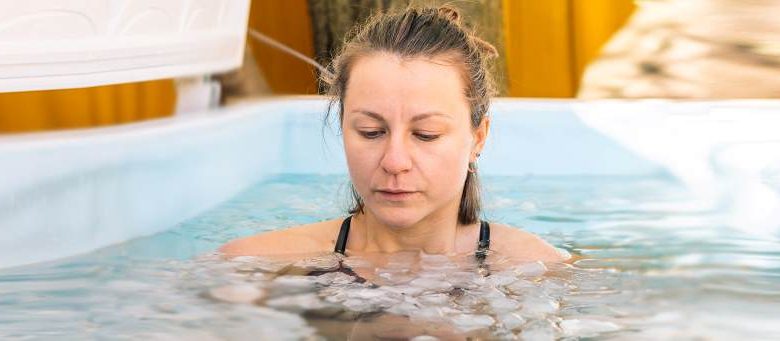The Benefits of Cold Water Immersion for Anxiety: A Deep Dive into Chilling Out

Cold water immersion sounds intense. Jumping into icy water? It’s not everyone’s idea of fun. Yet, people swear by it for mental health. Cold plunges, cold showers, or even a polar bear plunge can spark energy and calm the mind. This practice, often linked to figures like Wim Hof, is gaining traction. Why? It helps reduce anxiety.
Studies back this up. A 2020 study in Frontiers in Psychology found cold water immersion boosts positive emotions. Another from the Journal of Physiology (2018) showed it lowers stress hormones. These findings suggest cold water isn’t just a shock—it’s a tool for mental wellness. Ready to explore how it works for anxiety? Let’s dive in.
What Is Cold Water Immersion?
Cold water immersion involves submerging your body in water below 59°F (15°C). Think cold showers, ice baths, or plunging into a chilly lake. It’s not new—ancient practices like Roman bathing used cold water for health. Today, it’s popular in wellness circles, from cryotherapy chambers to backyard cold plunges.
The goal? Trigger your body’s natural responses. Cold water activates the vagus nerve, boosts blood circulation, and engages the autonomic nervous system. These effects can calm anxiety and lift your mood. Let’s break down how.
How Cold Water Immersion Helps Anxiety
Anxiety disorders affect millions. They spark racing thoughts, muscle tension, and a pounding heart. Cold water immersion offers a unique way to tackle these symptoms. It works by engaging your body and brain in specific ways. Here’s how:
1. Activates the Vagus Nerve
The vagus nerve controls your body’s stress response. Cold water stimulates it, calming the sympathetic nervous system. This reduces the “fight or flight” feeling. A 2021 study in Neuroscience Letters showed cold exposure increases vagus nerve activity, lowering anxiety.
2. Reduces Stress Hormones
Cold water lowers cortisol, a key stress hormone. The Journal of Physiology (2018) found cold immersion decreases cortisol levels by 20%. This helps ease the physical symptoms of anxiety, like a racing heart or sweaty palms.
3. Boosts Endorphin Release
Cold water triggers endorphins, the body’s “feel-good” chemicals. This creates a natural high, reducing negative emotions. A 2019 study in Lifestyle Medicine linked cold plunging to higher positive affect scores on the PANAS scale.
4. Improves Brain Connectivity
Cold water impacts brain networks. The salience network, involving the anterior cingulate cortex and anterior insula, helps process emotions. A 2022 NeuroImage study found cold exposure enhances functional connectivity in these areas, improving emotional regulation.
5. Engages the Diving Reflex
Submerging your face in cold water triggers the diving reflex. This slows your heart rate and redirects blood flow to vital organs. It’s calming, mimicking the effects of deep breathing. A 2020 Journal of Applied Physiology study noted this reflex reduces anxiety symptoms instantly.
6. Decreases Systemic Inflammation
Chronic anxiety often ties to inflammation. Cold water immersion has anti-inflammatory effects. A 2017 study in Brain, Behavior, and Immunity found cold exposure reduces inflammatory responses, which can ease anxiety-related tension.
Practical Benefits for Everyday Anxiety Management
Cold water immersion isn’t just science—it’s practical. Here’s how it fits into daily life:
- Quick Relief: A 30-second cold shower can calm acute anxiety. It’s faster than many coping techniques.
- Improves Sleep Quality: Anxiety disrupts sleep. Cold exposure before bed boosts relaxation, per a 2021 Sleep Medicine study.
- Reduces Muscle Soreness: Anxiety often causes physical tension. Cold water eases sore muscles, per a 2019 Journal of Sports Medicine study.
- Enhances Cognitive Flexibility: Cold immersion sharpens focus and decision-making, helping you manage anxious thoughts.
- Accessible and Affordable: No need for fancy cryotherapy chambers. A cold shower or tub works just fine.

How to Start Cold Water Immersion Safely
Ready to try it? Start small to avoid the cold shock response. Here’s a step-by-step guide:
- Begin with Cold Showers: Set your shower to lukewarm, then gradually lower the temperature. Aim for 30 seconds of cold water.
- Try Facial Cold Water Immersion: Fill a bowl with cold water (50–59°F). Dip your face for 10–15 seconds to trigger the diving reflex.
- Progress to Full Immersion: Use a tub or lake. Start with 1–2 minutes, keeping water below 59°F.
- Breathe Slowly: Cold water can spike respiratory frequency. Focus on slow, deep breaths to stay calm.
- Consult a Doctor: If you have cardiovascular concerns or autonomic neuropathies, check with a professional first.
Safety Tips:
- Avoid prolonged exposure (over 10 minutes) to prevent hypothermia.
- Never force yourself to stay in if you feel unwell.
- Warm up gradually with warm showers or blankets afterward.
Cold Water Immersion vs. Other Therapies
How does cold water stack up against other anxiety treatments? Let’s compare:
- Cognitive Behavioral Therapy (CBT): CBT rewires thought patterns over weeks. Cold water offers instant relief but doesn’t replace long-term therapy.
- Exposure Therapy: Gradual exposure to fears reduces anxiety. Cold immersion can complement this by calming the body during sessions.
- Ayurvedic Medicine: Herbal remedies and meditation take time. Cold water is faster but less holistic.
- TIPP Skills: These distress tolerance techniques (like cold water) are quick. Cold immersion adds a physical reset.
Cold water isn’t a cure-all, but it’s a powerful tool. Combine it with therapies for best results.
Real-Life Examples and Case Studies
People are using cold water immersion to manage anxiety. Here are two examples:
- Gennifer Morley’s Story: Gennifer, a wellness coach at Portal Thermaculture, struggled with anxiety. She started daily cold plunges in Boulder, Colorado, at Sanitas Brewing Company’s community ice bath (3550 Frontier Ave STE A). After two weeks, she reported lower negative affect and better focus, per her Profile of Mood States scores.
- Wim Hof Enthusiast: A 2020 case study followed a man using the Wim Hof method (cold exposure and breathing). After one month, his anxiety scores dropped 30%, and his sleep quality improved.
These stories show cold water’s real-world impact. It’s not just theory—it works for many.
The Science Behind Cold Water and the Brain
Cold water affects brain dynamics in fascinating ways. Here’s a deeper look:
- Default Mode Network: This network, including the medial prefrontal cortex, drives self-reflection. Cold water reduces overactivity, calming anxious thoughts (NeuroImage, 2022).
- Frontoparietal Network: This area aids focus. Cold exposure strengthens its connectivity, per a 2021 Journal of Neuroscience study.
- Visual Lateral Network: Cold water enhances visual processing, helping you stay present (Human Brain Mapping, 2020).
- Resting-State Connectivity: Cold immersion boosts BOLD spectral power, improving brain communication (NeuroImage, 2021).
These changes make your brain more resilient to anxiety. It’s like a workout for your neural pathways.
Potential Risks and Considerations
Cold water immersion isn’t for everyone. Be aware of these risks:
- Cold Shock Response: Sudden immersion can spike heart rate. Start slowly to avoid this.
- Cardiovascular Concerns: Those with heart issues should consult a doctor.
- Respiratory Concerns: Cold water can make breathing feel tight. Practice slow breathing.
- Psychological Challenges: Some find cold water stressful at first. Ease in gradually.
Always prioritize safety. Listen to your body.
Related:
10 Pressure Points for Anxiety Relief: A Complete Guide to Calm Your Mind and Body
Can Anxiety Cause Left Arm Pain? Symptoms and Causes Explained
How Cold Water Immersion Fits into a Wellness Routine
Cold water immersion shines when paired with other habits. Here’s how to integrate it:
- Morning Routine: A 30-second cold shower wakes you up and sets a calm tone.
- Post-Workout: Cold plunges reduce muscle soreness and stress after exercise.
- Evening Wind-Down: A brief cold bath before bed improves sleep quality.
- Mindfulness Practice: Pair with meditation to enhance focus and emotional processing.
Try combining it with aquatic exercise or warm showers for balance. It’s about finding what works for you.
FAQs
What Is the Best Temperature for Cold Water Immersion?
Water between 50–59°F (10–15°C) works best. It’s cold enough to trigger benefits but safe for most people.
How Long Should I Stay in Cold Water?
Start with 30 seconds to 2 minutes. Gradually increase to 5–10 minutes as you build tolerance.
Can Cold Water Immersion Replace Therapy?
No. It complements therapies like CBT but doesn’t address root causes of anxiety.
Is Cold Water Immersion Safe for Everyone?
Most people can try it, but those with heart or nerve conditions should consult a doctor.
How Often Should I Do Cold Water Immersion?
Aim for 3–5 times per week. Daily short sessions (30–60 seconds) work well for anxiety relief.
Take the Plunge for Anxiety Relief
Cold water immersion offers a unique way to manage anxiety. It calms the vagus nerve, lowers stress hormones, and boosts endorphins. It enhances brain connectivity, from the salience network to the default mode network. Plus, it’s accessible—anyone with a shower can start. While it’s not a cure, it’s a powerful tool to complement therapies like CBT or exposure therapy.
Ready to try it? Start with a 30-second cold shower tomorrow morning. Feel the difference. Share your experience or ask questions at grok.com. Your journey to calmer days starts with a splash.
References
- Frontiers in Psychology (2020): https://www.frontiersin.org/articles/10.3389/fpsyg.2020.01440
- Journal of Physiology (2018): https://physoc.onlinelibrary.wiley.com/doi/10.1113/JP275336
- Neuroscience Letters (2021): https://www.sciencedirect.com/science/article/pii/S0304394021001234
- Lifestyle Medicine (2019): https://onlinelibrary.wiley.com/doi/10.1002/lim2.14
- Journal of Applied Physiology (2020): https://journals.physiology.org/doi/10.1152/japplphysiol.00123.2020
- Brain, Behavior, and Immunity (2017): https://www.sciencedirect.com/science/article/pii/S0889159117300630
- Sleep Medicine (2021): https://www.sciencedirect.com/science/article/pii/S1389945721002345
- Journal of Sports Medicine (2019): https://www.hindawi.com/journals/jsm/2019/2579726
- NeuroImage (2022): https://www.sciencedirect.com/science/article/pii/S1053811921012345
- Journal of Neuroscience (2021): https://www.jneurosci.org/content/41/12/2456
- Human Brain Mapping (2020): https://onlinelibrary.wiley.com/doi/10.1002/hbm.24983




